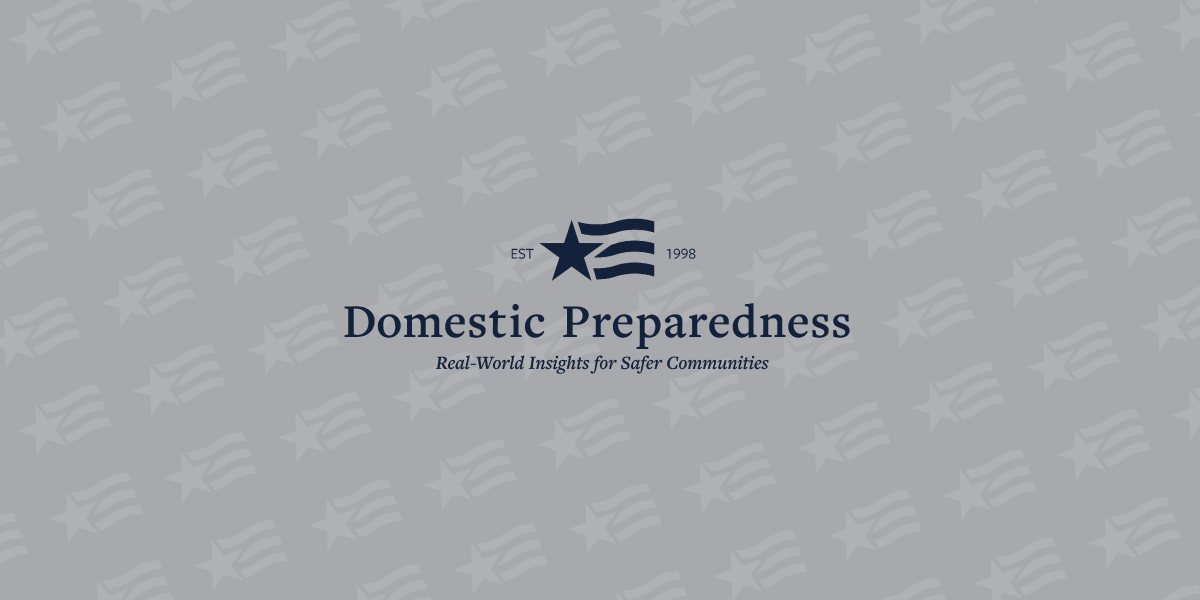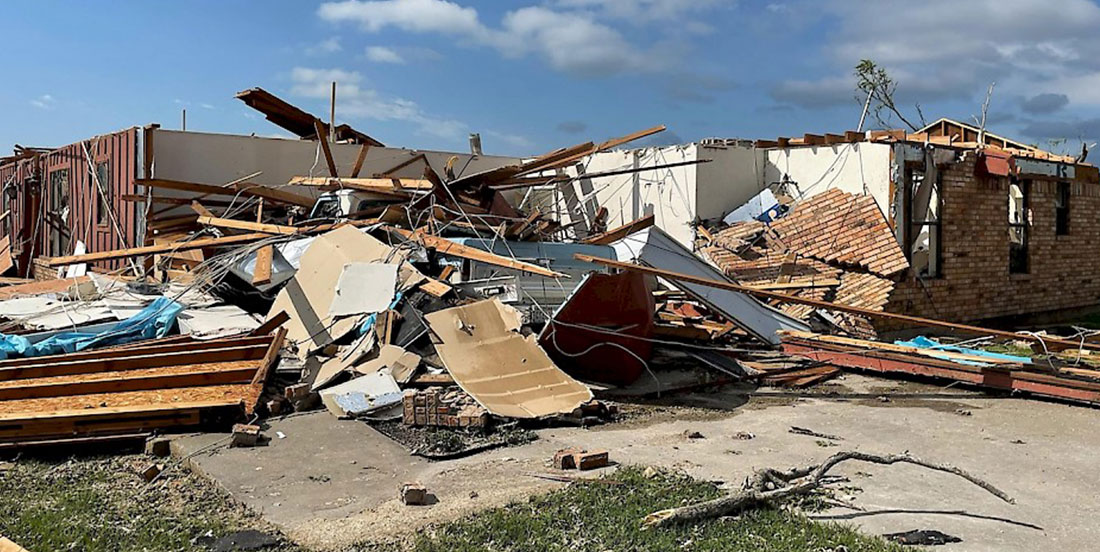Most recently published

Biosafety Laboratory Issues and Failures
Robert C. Hutchinson
April 12, 2023
Concerns regarding unexpected biological incidents and their public health implications were discussed in a 2014 Domestic Preparedness biosecurity and bioterrorism article. From the improper possession and storage of decades-old live smallpox virus in a former Food and Drug Administration laboratory (lab) on the National Institute of Health (NIH) campus to

Hazmat on the Rail
Glen Rudner
April 5, 2023
Since February 3, 2023, following the train derailment in East Palestine, Ohio, the public has closely followed reports and commentary by media outlets and elected officials. This incident has become more controversial and publicized than others in recent years and has caused a public outcry for change.

Preparing the Next Generation for Increasing Disasters
Kay C. Goss
April 5, 2023
Preparing the next generation of emergency preparedness and response professionals requires educational programs that teach critical thinking and life-saving strategies. Many programs and resources address these needs, but more educational and collaborative opportunities should be considered to meet the growing needs.

Information Sharing – A Powerful Life-Saving Tool
Catherine L. Feinman
March 29, 2023
Information sharing is a valuable tool used for various purposes. However, this tool’s power in preparing for and responding to emergencies should not be underestimated. Unfortunately, critical information and data can sometimes be misused, not effectively leveraged, not shared, or simply ignored. In these scenarios, it is more difficult to

Guidance for Preparing Professionals Mentally for the Worst
James Greenstone and Weldon Walles
March 22, 2023
Professional groups have debated and researched the best practices relating to the standards and quality of care sufficient to maintain minimum standards during a disaster. Due to the fluid nature of a disaster, it is difficult to abide by a standard that will fit every situation. For example, the onset

Challenging the Next Generation to Communicate Preparedness
Chris Sheach
March 22, 2023
No single communication solution can apply to every situation. To better prepare the next generation of public safety professionals, one professor is challenging young adults to develop social media messaging that reaches diverse populations and encourages action to protect lives and property during emergencies.

A National Plan to Link Response and Recovery
Robert J. (Bob) Roller
March 15, 2023
In March 2023, FEMA published the Response and Recovery Federal Interagency Operational Plan. Learn about this big step forward for the emergency management community – the development and content of this new plan as well as the next steps for key stakeholders.

Tornadoes – Adapting Plans for a Changing Environment
Cameron Gonteski
March 15, 2023
Common terms like “Tornado Alley” should not get in the way of planning for evolving environmental threats. Meteorologists look at trends and recognize that tornadoes are one natural hazard that is shifting eastward. Make sure state and local hazard mitigation plans are updated and ready for this shift.

Leader of the Pack – Canine Detection
Barb Clark
March 8, 2023
In the wake of a disaster, time is critical for locating survivors and recovering bodies. This type of work requires training, skills, and abilities acquired by canines due to their unique anatomy and physiology. However, there are key considerations before implementing K9 programs.

Fostering Public Buy-In to Support Public Safety
Taylor Bonsall-Winn
March 8, 2023
Emergency managers often go unnoticed until a disaster occurs. However, disaster response efforts are much more effective when communities work together and trust their local responding agencies. Learn how one county has changed its mindset to develop stronger community partnerships and buy-in before the next disaster.

An Integrated Public Safety Approach for Evolving Threats
Eva Jernegan
March 1, 2023
Evolving threats require integrated public safety approaches. Concepts like the Rescue Task Force, models like the Cynefin Framework, and numerous other available resources can help communities develop collaborative response plans for evolving threats and complex coordinated attacks like fire as a weapon.

Data Sharing – A Necessary Public Safety Tool
Michael Breslin
March 1, 2023
Criminal activities are not limited to jurisdictional boundaries, nor should the ability to share information collaboratively. Cooperative data sharing within and between jurisdictions is essential for today’s law enforcement demands. As such, law enforcement and other public safety agencies must work together to create a safer and more just society.

The DoD Defense Coordinating Element and How It Is Certified
Patrick McNiece
April 12, 2023
Besides the main mission of defending the homeland, Department of Defense capabilities also provide critical support to local, state, and federal civilian partners during major disasters. Learn how Army North’s defense coordinating element’s mission and composition ready their units to perform this additional mission when needed.

Biosafety Laboratory Issues and Failures
Robert C. Hutchinson
April 12, 2023
Concerns regarding unexpected biological incidents and their public health implications were discussed in a 2014 Domestic Preparedness biosecurity and bioterrorism article. From the improper possession and storage of decades-old live smallpox virus in a former Food and Drug Administration laboratory (lab) on the National Institute of Health (NIH) campus to

Hazmat on the Rail
Glen Rudner
April 5, 2023
Since February 3, 2023, following the train derailment in East Palestine, Ohio, the public has closely followed reports and commentary by media outlets and elected officials. This incident has become more controversial and publicized than others in recent years and has caused a public outcry for change.

Preparing the Next Generation for Increasing Disasters
Kay C. Goss
April 5, 2023
Preparing the next generation of emergency preparedness and response professionals requires educational programs that teach critical thinking and life-saving strategies. Many programs and resources address these needs, but more educational and collaborative opportunities should be considered to meet the growing needs.

Information Sharing – A Powerful Life-Saving Tool
Catherine L. Feinman
March 29, 2023
Information sharing is a valuable tool used for various purposes. However, this tool’s power in preparing for and responding to emergencies should not be underestimated. Unfortunately, critical information and data can sometimes be misused, not effectively leveraged, not shared, or simply ignored. In these scenarios, it is more difficult to

Guidance for Preparing Professionals Mentally for the Worst
James Greenstone and Weldon Walles
March 22, 2023
Professional groups have debated and researched the best practices relating to the standards and quality of care sufficient to maintain minimum standards during a disaster. Due to the fluid nature of a disaster, it is difficult to abide by a standard that will fit every situation. For example, the onset

Challenging the Next Generation to Communicate Preparedness
Chris Sheach
March 22, 2023
No single communication solution can apply to every situation. To better prepare the next generation of public safety professionals, one professor is challenging young adults to develop social media messaging that reaches diverse populations and encourages action to protect lives and property during emergencies.

A National Plan to Link Response and Recovery
Robert J. (Bob) Roller
March 15, 2023
In March 2023, FEMA published the Response and Recovery Federal Interagency Operational Plan. Learn about this big step forward for the emergency management community – the development and content of this new plan as well as the next steps for key stakeholders.

Tornadoes – Adapting Plans for a Changing Environment
Cameron Gonteski
March 15, 2023
Common terms like “Tornado Alley” should not get in the way of planning for evolving environmental threats. Meteorologists look at trends and recognize that tornadoes are one natural hazard that is shifting eastward. Make sure state and local hazard mitigation plans are updated and ready for this shift.

Leader of the Pack – Canine Detection
Barb Clark
March 8, 2023
In the wake of a disaster, time is critical for locating survivors and recovering bodies. This type of work requires training, skills, and abilities acquired by canines due to their unique anatomy and physiology. However, there are key considerations before implementing K9 programs.

Fostering Public Buy-In to Support Public Safety
Taylor Bonsall-Winn
March 8, 2023
Emergency managers often go unnoticed until a disaster occurs. However, disaster response efforts are much more effective when communities work together and trust their local responding agencies. Learn how one county has changed its mindset to develop stronger community partnerships and buy-in before the next disaster.

An Integrated Public Safety Approach for Evolving Threats
Eva Jernegan
March 1, 2023
Evolving threats require integrated public safety approaches. Concepts like the Rescue Task Force, models like the Cynefin Framework, and numerous other available resources can help communities develop collaborative response plans for evolving threats and complex coordinated attacks like fire as a weapon.
Threat Awareness – Actions Now Mitigate Disasters Later
Catherine L. Feinman
February 22, 2023
Reducing or eliminating the long-term risks associated with natural, human-caused, or technological disasters begins with an awareness that specific threats exist. For example, a Chinese spy balloon crossed the United States and was shot down on February 4, 2023. The exact level of threat that it posed and the
Protests: Balancing First Amendment Rights and Public Safety
Matthew Loeslie
February 22, 2023
In today’s society, peaceful protests can occasionally escalate into unlawful rioting. The behavior of those involved in a demonstration or public gathering can vary greatly. This behavior includes: Peaceful protests, actions, and speech that are lawful and protected by the Constitution; Civil disobedience, which typically involves minor criminal acts; and Rioting associated with
Linking Resilience and Innovation for Emergency Preparedness
Nia D'Emilio and Christopher Tarantino
February 15, 2023
Most industries suggest a certain level of resilience and innovation. It is important to get through challenging times to keep a company going, and “innovate or die” has long been a mantra of the business world. While these concepts – or in some cases, buzzwords – come up in various lines of
Trends in Political Violence and Mass Demonstrations
Richard Schoeberl
February 15, 2023
Article Out Loud More than 400 worldwide antigovernment protests have taken place since 2017. According to the Global Peace Index (GPI), the incidents of civil unrest have doubled across the globe over the past decade. Moreover, the 2022 GPI indicates the world has become “less peaceful for the eleventh time in the
Building Business Post-Disaster – A Florida Case Study
Mark McQueen
February 8, 2023
Opportunities can be found in the wake of great devastation. However, it can be challenging to plan for the future while restoring critical services and repairing the damage left in the crisis’s wake. Recovery plans should look beyond what existed before the disaster and include laying a foundation for regrowth
PACEing a Communications Resilience Plan
Charles J. Guddemi
February 8, 2023
Most organizations have a daily operational plan for their communications that works most of the time and a backup plan for a short-term problem. However, many do not have a primary, alternate, contingency, emergency (PACE) plan for critical operational tasks. Learn more about the benefits of creating and maintaining a
Threat Assessment and Management: Practices Across the World
Carl Amritt, Eliot Bradshaw and Alyssa Schulenberg
February 1, 2023
The ever-evolving threat of terrorism continues to impact cities around the world. The Global Terrorism Index shows that in 2021, the number of attacks increased from the previous year by 17 percent to 5,226. As actors adapt and change their tactics and techniques, cities must develop new capabilities to counter these threats.
Winter Storm – Reimagining Recovery Using Support Functions
Jamie Hannan and Stephanie Wright
February 1, 2023
Out of first-time events come many important lessons learned. For example, information must be disseminated using familiar terminology when an unfamiliar event occurs. In addition, recovery is a team effort that begins before the event has ended. Learn how the third most populated county in the United States handled recovery
Strong Foundations – What Every Disaster Plan Needs
Catherine L. Feinman
January 25, 2023
The initial goal of a disaster plan should be to avoid the disaster. The secondary goal should be to respond effectively when a disaster cannot be avoided. To be clear, the disaster here is not a hurricane, earthquake, flood, wildfire, tornado, or even human attacker. These are simply examples of
Crisis Standards of Care – A Mental Health Perspective
James Greenstone
January 25, 2023
Crisis standards of care and sufficiency of care are topics of great controversy and debate in professional circles. The reasons may be obvious to most. Traditionally, health care responders are trained and held to the standard of care of their profession when rendering aid. Nothing less is acceptable. The public
Applications for a Newly Developed Risk and Resilience Tool
Kyle Pfeiffer, Rao Kotamarthi and Christina Nuñez
January 25, 2023
A new, publicly available tool provides a window into how future climate realities could affect U.S. cities and towns. Learn how planners and decision-makers can get map-based analyses driven by peer-reviewed climate data using this free portal.
Virtual Reality Training Revolution Is Here
Peter Johnson
January 18, 2023
The click-through, good-enough training, ubiquitous in many organizations, is not good enough anymore. A Harvard Business Review article titled “Where Companies Go Wrong with Learning and Development” (L&D) discovered that only 12% of employees applied training from L&D programs to their work. The same article explains that hundreds of billions of dollars are spent annually
Follow Us
Get Instant Access
Subscribe today to Domestic Preparedness and get real-world insights for safer communities.


